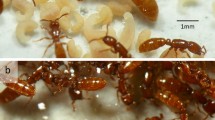Summary
The dimorphic ant specicsP. pallidula is widespread in all Mediterranean countries and was the dominant species in our study area. Demographic data such as relative abundance, density, spatial distribution were collected and quantitative observations ofP. pallidula behaviour were made at the time of food exploitation. This allowed us to discern the relations, particularly competitives ones, between their workers and other sympatric ant species (Aphaenogaster senilis, Crematogaster sordidula, Messor barbara, Plagiolepis pygmaea). The ecological success ofP. pallidula seems to depend on 3 main characteristics of its ethology:
-
1o)
its foraging activity both diurnal and nocturnal,
-
2o)
the diversity of its foraging techniques (individual and collective retrievals by minor foragers; short and long lasting foraging trails).
-
3o)
the active participation of majors in intense exploitation of large unretrievable food sources where they could be very efficient to protect food sources from competitors and/or to cut preys' sclcrites. These majors are mainly present on food sources and on trails, exploration of the foraging area being ensured by the minor caste. The adaptive significance of caste polyethism ofP. pallidula species during food exploitation is discussed according to our field data.
Resume
L'espèce à caste neutre dimorphiqueP. pallidula largement répandue dans toute la région méditerranéenne est nettement dominante dans notre site d'étude. Des données démographiques (abondance relative, densité et distribution spatiale) ainsi que des observations quantifiées des comportements deP. pallidula lors de la récolte de nourriture permettent de cerner ses relations, notamment de compétition, avec d'autres fourmis sympatriques (Aphaenogaser senilis, Crematogaster sordidula, Messor barbara, Plagiolepis pygmaea). Le succès écologique deP. pallidula semble tenir à trois caractéristiques éthologiques:
-
1o)
son activité de récolte à la fois diurne et nocturne,
-
2o)
la diversité de ses techniques de récolte (récolte individuelle et collective de nourriture par les minors de la société, pistes alimentaires de courte et de longue durée).
-
3o)
la participation active d'une caste neutre de majors à l'exploitation intense de larges sources de nourriture, susceptibles d'assurer la protection efficace de ces sources contre des espèces compétitrices et/ou la découpe des proies. Sur l'aire de récolte, ces majors sont toujours présentes aux sources de nourriture et sur les pistes alimentaires, l'exploration du territoire étant essentiellement dévolue à la caste minor. La signification adaptative du polyéthisme de castes deP. pallidula lors de la récolte est discutée sur base de nos résultats.
Similar content being viewed by others
References
Ballard J.B., Pruess K.P., 1979. — Seed selection by an ant,Pheidole bicarinata longula Emery (Hymenoptera: Formicidae).J. Kans. Entomol. Soc., 52, 550–552.
Bernard F., 1980. — Rôle du terrain et de la végétation dans la répartition des fourmis méditerranéennes de France.C. R. Soc. Biogéog., 485, 149–154.
Bhatkar P., 1982. — Depredacion por hormigas sobre insectos que infestan semillas.Folia Entomol. Mex., 54, 79–80.
Brown W.L., Davidson D.W., 1977. — Competition between seed-cating rodents and ants in desert ecosystems.Science, 196, 880–882.
Creighton W., 1966. — The habits ofPheidole ridicula Wheeler with remarks on habit patterns in the genusPheidole (Hymenoptera: Formicidae).Psyche, 73 (1), 1–7.
Davidson D.W., 1981. — Some consequences of diffuse competition in a desert ant community.Am. Nat., 116, 523–532.
Delalande C., 1985. — Rythmes d'activité de quelques espèces de fourmis en région méditerranéenne (Hym. Formicidae).Actes Coll. Insect. Soc., 2, 303–318.
Detrain C., 1989. — Polyphénisme de la caste neutre chezPheidole pallidula (Hymenoptera: Formicidae) en relation avec la récolte de nourriture et la défense de la société.Thèse de doctorat de l'Université Libre de Bruxelles, 193 p.
Detrain C., Pasteels J.M., Deneubourg J.L., 1988. — Polyéthisme dans le tracé et le suivi de la piste chezPheidole pallidula (Formicidae).Actes Coll. Insectes Soc., 4, 87–94.
Du Merle P., Jourdheuil P., Marro J.P., Mazet R., 1978. — Evolution saisonnière de la myrmécofaune et de son activité prédatrice dans un milieu forestier: les interactions clairière-lisière-forêt.Ann. Soc. Ent. Fr., 14, 141–158.
Fluker S., Beardsley J.W., 1970. — Sympatric associations of three ants:Iridomyrmex humilis, Pheidole megacephala andAnoplolepis longipes in Hawaï.Ann. Ent. Soc. Am., 63, 1290–1296.
Fowler H.G., 1984. — Recruitment, group retrieval and major worker behavior inPheidole oxyops Forel (Hymenoptera: Formicidae).Rev. Brasil. Biol., 44, 21–24.
Hölldobler B., Möglich M., 1980. — The foraging system ofPheidole milicida (Hymenoptera: Formicidae).Insectes Soc., 27, 237–264.
Itzkowitz M., Haley M., 1983. — The food retrieval tactics of the antPheidole fallax Mayr.Insectes Soc., 30, 317–322.
Kemp P.B., 1951. — Field observations on the activity ofPheidole.Bull. Ent. Res. London, 42, 201–206.
Melhop P., Scott N.J., 1983. — Temporal patterns of seed use and availability in a guild of desert ants.Ecol. Entomol., 8, 69–85.
Oster G.F., Wilson E.O., 1978. — Caste and ecology in social insects.Princeton University Press, Princeton.
Passera L., 1977. — Production des soldats dans les sociétés sortant d'hibernation chez la fourmiPheidole pallidula (Nyl.) (Formicidae, Myrmicinae).Insectes Soc., 24, 131–146.
Risch S., 1981. — Ants as important predators of rootworm eggs in the Neotropics.J. Econ. Ent., 74, 88–90.
Schmid-Hempel P., 1987. — Foraging characteristics of the desert antCataglyphis.Experienta Supplementum, 54, 43–61.
Sheppe W., 1970. — Invertebrate predation on termites of the African savanna.Insectes Soc., 17, 205–208.
Szlep-Fessel R., 1970. — The regulatory mechanisms in mass foraging and the recruitment of soldiers inPheidole.Insectes Soc., 17, 233–244.
Traniello J.F., 1987. — Social and individual responses to environmental factors in ants.Experientia Supplementum, 54, 63–80.
Wheeler W.M., 1910. — Ants: their structure, development and behavior.Columbia Univ. Press, New York, 663 p.
Whitford W.G., 1978. — Structure and seasonal activity of Chihuahuan desert ant communities.Insectes Soc., 25, 79–88.
Whitford W.G., Depree D.J., Hamilton P., Ettershank G., 1981. — Foraging ecology of seed-harvesting ants,Pheidole spp., in a Chihuahuan desert ecosystem.Am. Midl. Nat., 105, 159–167.
Wilson E.O., Hölldobler B., 1985. — Caste-specific techniques of defense in the polymorphic antPheidole embolopyx (Hymenoptera: Formicidae).Insectes Soc., 32, 3–22.
Author information
Authors and Affiliations
Rights and permissions
About this article
Cite this article
Detrain, C. Field study on foraging by the polymorphic ant species,Pheidole pallidula . Ins. Soc 37, 315–332 (1990). https://doi.org/10.1007/BF02225995
Received:
Accepted:
Issue Date:
DOI: https://doi.org/10.1007/BF02225995




